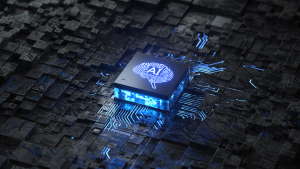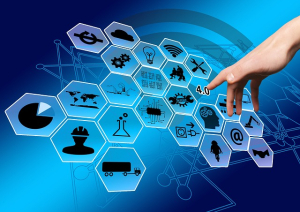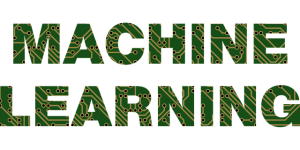Industry 4.0: What Manufacturers Need to Know

Industry 4.0 refers to the 4th Industrial Revolution, a shift in the way manufacturing and other industries operate and the knock-on economic effects. Technological innovations have historically triggered surges in production and economic activity. The first industrial revolution was spurred by the widespread adoption of steam power and the invention of cast iron in the late 18th century, bringing about railways and a boom in coal mining, iron-based architecture, steel manufacturing and mechanisation. Manufacturing was suddenly done by machines, some of which were huge and dangerous to operate. Through the 19th and 20th centuries, rapid scientific discovery, mass production and urbanisation characterised a second shift, while the third is characterised as the Digital revolution.
In the twenty-first century, we are faced with the integration of digital technologies and computing power with mechanised manufacturing and mass production. Manufacturing automation, smart factories and internet-enabled devices are becoming industry standards as Industry 4.0 gets underway.
Defining Industry 4.0
 Industry 4.0 as a phrase borrows from iterative programming shorthand to refer to the Fourth Industrial Revolution, also known as 4IR. Any industrial revolution refers to a surge of productivity brought about by innovations that become widely adopted.
Industry 4.0 as a phrase borrows from iterative programming shorthand to refer to the Fourth Industrial Revolution, also known as 4IR. Any industrial revolution refers to a surge of productivity brought about by innovations that become widely adopted.
Industry 4.0 is the convergence of information technology (IT) and operational technology (OT). This convergence is multifaceted, creating a shift propelled by multiple innovations. These can be generally sorted into 4 categories:
- The Internet of Things: connective technology, cloud computing, internet integration, blockchain and sensor-based automation
- Technological Augmentation: Augmented Reality (AR) glasses, Robotics and Automation, Autonomous Material Handling, Light-Directed Material Handling
- Analytics and Machine Learning: advanced data analytics, computer vision, artificial intelligence
- Advanced Engineering: 3D Printing, Renewable Energy, bioplastics, renewable materials
These areas are coming together to create smart factories, more automated manufacturing and supply chains and a wholesale shift in how products are created. In this article, we will discuss automation through IoT technologies and Technological Augmentation, as well as some ways manufacturers can succeed in the fourth industrial revolution.
Combining the Internet of Things (IoT), Analytics and Machine Learning
 A key component of smart factories, the Internet of Things is a concept described by computer scientist Kevin Ashton in 1999 when he proposed tracking products through a supply chain with radio-frequency identification chips. Today, IoT devices include those that can be controlled or tracked via the internet, such as app-controlled home heating systems, Alexa and Google Home devices or your smart doorbell.
A key component of smart factories, the Internet of Things is a concept described by computer scientist Kevin Ashton in 1999 when he proposed tracking products through a supply chain with radio-frequency identification chips. Today, IoT devices include those that can be controlled or tracked via the internet, such as app-controlled home heating systems, Alexa and Google Home devices or your smart doorbell.
In manufacturing, internet-enabled devices and advanced data analysis programming can revolutionise the way machinery and material handling systems are used. Some use cases that illustrate the way these two aspects work together to create smart factories include:
- Predictive Maintenance: Using data gathered by sensors, algorithms are able to predict potential malfunctions and alert maintenance, preventing unplanned downtime.
- Warehouse Execution Systems: With a central software hub for control and analysis of connected devices, your facility can leverage data from inventory, processes and equipment to adapt to fluctuating demands quickly and effectively.
- Computer Vision for Quality Control: With machine learning, programs can quickly grow in accuracy when detecting defects and contaminants in the material input or final product.
Add in Technological Augmentation
Technological solutions for manufacturing are shifting heavy labour and tasks involving minute attention to detail from humans to machines. Examples of augmentation include:
- Scanners: handheld or otherwise, used to read bar codes more accurately
- Autonomous Material Transport: e.g. Autonomous Mobile Robots (AMRs) used to transport goods, parts and completed products around a facility
- Light-Directed Picking Technology: e.g. Pick to Light (PtL), used to direct workers to pick the correct parts or SKUs for an order or assembly.
3 Key Points for Industry 4.0 Success
Mitigate Workforce Disruption with Training
As with any shift in technological capability, companies intending to thrive in this new industrial landscape must bring their workforce along with them. Ensuring workers are properly equipped to support the adoption of new technologies requires “upskilling and reskilling” – training, in short.
It is thought that manufacturing in the next decade will require skilled engineers more than unskilled labourers. Research by McKinsey Global Institute suggests that as much as 25% of tasks in manufacturing could be automated by 2025. However, forecasts predict many more jobs will be created by automation, encouraging companies to consider which roles could evolve to include the skills required to support smart factory work, such as maintenance, troubleshooting, programming and configuration.
Encouraging a culture of lifelong learning must become more common at every level of organisations, as workers develop new skills for a more digitised future. What this requires, however, is time dedicated to training.
Working with schools, colleges and universities to provide apprenticeships and training opportunities in these emerging areas will help bolster the workforce of tomorrow and cover any skills gap in the coming years.
Experts argue for strategies which integrate this training into daily routines, rather than delivering classroom-style learning in a separate context. By deploying digitised learning resources with easily digested information, manufacturers can train current employees to collaborate with automation technologies more easily.
Grow Confidence in Data Sharing
Almost all of these emerging technologies and trends work with data shared over online networks. AMRs use data on the facility layout, Pick-to-Light systems use data on product and order lists, and centralised automation software uses data from all across the plant. This is great if you have a single facility, but where businesses have more widespread networks, data sharing across factories, warehouses and distribution centres can create a holistic and hyper-efficient system. This uptick in data sharing requires stronger encryption and security.
On another note, many industries and manufacturing businesses are adopting advanced analytics and machine learning to reduce downtime and increase throughput. These AI models and algorithms need to be trained on large data sets, which presents a challenge.
Not all manufacturers have sufficient internal data to train AIs. To get around this issue, data sharing between vendors and partners has become more common. This creates a larger pool of data, such as images of damaged or defective products, which enables manufacturers to train and enhance their machine-learning assets, such as quality control programs. Data sharing also fosters closer collaboration with partners, allowing companies to track products along the value chain and verify the provenance of their materials.
To reap the benefits of shared data sets, manufacturers need to create stronger digital encryption systems and robust data-sharing agreements and ensure that all partners are confident in the way their data is used and stored.
Adopt Flexible Automation
Developments in automation and robotics have generated a range of multi-purpose machines that work more quickly and are more adaptive than the initial manufacturing machinery. While early automation was built for completing repetitive tasks with speed, recent robotics development has focussed on flexibility.
For example, the same AMR can be modified with AMR top modules to assist with various material handling tasks throughout a facility, such as conveyor tops, pick-to-light carts or robotic arms. Similarly, a robotic arm could be programmed to accommodate different assembly tasks to build multiple SKUs on the same line without swapping equipment. In addition, 3D printing is rapidly changing the way components and parts are produced due to the technology’s rapid adoption in plastics, automotive and medical production.
Automation that can adapt is much better equipped for rapidly changing markets and economies. By adopting flexible solutions, manufacturers will build resiliency into their systems, carrying the benefits of automation over when demand changes.
Flexible Automation is scaleable, too. With a robust overview of the existing manufacturing process, manufacturers can identify the optimum points for automation and adopt flexible solutions. This can be repeated across the whole workstream so that all solutions, from AMRs to marking machines are integrated into a holistic automation system.
Conclusion: Many Moving Parts for Smart Manufacturing Shift
Industry 4.0 is transforming manufacturing around the world, and staying competitive will require bold steps towards flexible automation. Any size of business can benefit from integrating automated solutions, data sharing and connectivity. The challenge, however, is to gain an objective view of the whole business and to implement solutions in a way that is flexible and connected. At Guidance Automation, we provide advice as automation consultants, connecting customers with the technologies that fit their organisations.
To contact Guidance Automation to request a consultation, call 0116 243 6250.




